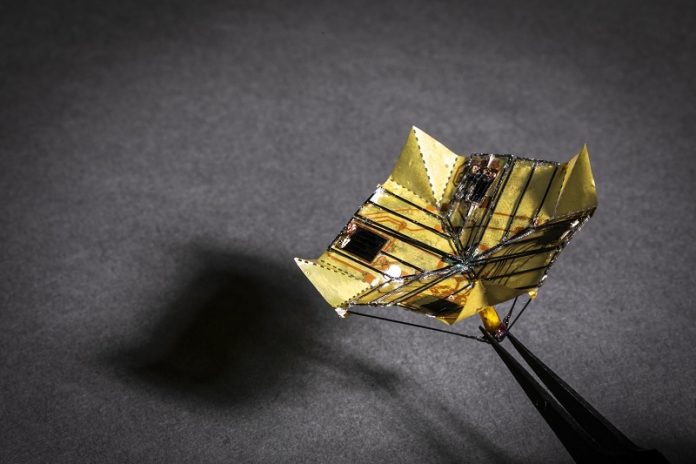
Scientists at the University of Washington have made some cool mini robots that change shape while flying down from the sky.
Imagine a paper airplane that can fold itself into a different shape while it’s still in the air! These little flying gadgets do something like that.
They call them “microfliers,” and they’re as light as half a nail. These microfliers can be dropped from a drone and can travel the distance of a football field.
That’s about 131 feet! What’s super exciting is that they don’t need batteries to work.
So, how do these little guys change shape while flying? They use a special folding trick called Miura-ori origami.
If you’ve ever folded paper into different shapes, you’ll get the idea. This specific way of folding is like the patterns you see on leaves.
When the microfliers are first released from a drone, they flutter and spin around like crazy, almost like a leaf falling from a tree. But then, they can fold themselves into a different shape that allows them to drop straight down to the ground. This happens really fast, in just 25 milliseconds. That’s faster than a blink of an eye!
These robots are smart. They can decide when to change shape using different methods. They can use a tiny sensor that figures out how high they are from the ground, or they can use a built-in timer. They can even receive a signal over Bluetooth from a controller.
Powering up without batteries
You might be wondering how they get the energy to fold. Well, they soak up sunlight through a little circuit that turns it into power.
This means they don’t need any batteries, making them super lightweight and easy to use.
Aside from flying really far for their size, these microfliers can carry small sensors. These sensors can check things like temperature and humidity as they fly.
So they can be used for all kinds of useful things, like checking weather conditions or maybe even helping in search and rescue missions.
Right now, these microfliers can only change shape in one way: they can go from tumbling around to falling straight down.
But the scientists are already thinking about the next steps. They want to make versions that can change shape in more ways, which would help them land more precisely, even when the wind is blowing hard.
So, the next time you see a leaf falling from a tree, just imagine if it could change shape and glide to a specific spot on the ground.
That’s the magic that these scientists are bringing to life with their tiny flying robots.
Follow us on Twitter for more articles about this topic.
Source: University of Washington.



